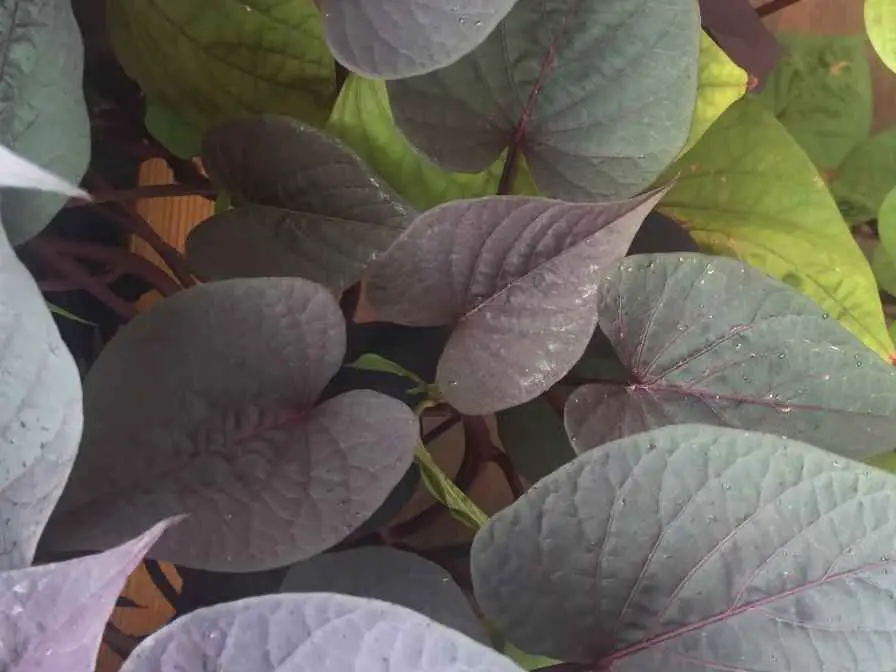Purple sweet potato vines are the different variety of sweet potato vines. These are used for ornamental value as well as you can eat it. Crucial is whether you know how to plant purple sweet potato vines or not. Well, we are going to tell you about that.

Purple Sweet Potato Vines
Purple sweet potato vines, also known as purple sweet potato leaves, are the foliage of the sweet potato plant (Ipomoea batatas, Blackie) that produce tubers that are commonly consumed as root vegetables.
These vines have a deep purple color that intensifies with exposure to sunlight and are often used as an ornamental plant in gardens due to their attractive coloration. They are native to tropical regions of Central and South America but are now widely cultivated around the world.
The leaves of the purple sweet potato vine are edible and have a slightly sweet flavor, similar to spinach or Swiss chard. They are a good source of vitamin A, vitamin C, and dietary fiber. In some cultures, the leaves are used in soups, stews, and stir-fries, while in others they are simply steamed or blanched and served as a side dish.
The leaves can also be used to wrap other foods for cooking, such as rice or fish, imparting their unique flavor and color. Aside from their culinary uses, purple sweet potato vines have also been used in traditional medicine for their various health benefits.
The leaves are believed to have anti-inflammatory and anti-cancer properties, as well as being a good source of antioxidants. Additionally, the vines contain compounds that may have a positive effect on blood sugar levels, making them a potential diabetes treatment.
While more research is needed to fully understand the health benefits of purple sweet potato vines, their culinary versatility and potential medicinal properties make them a valuable addition to any diet.
Benefits of Planting Purple Sweet Potato Vines
There are many benefits of planting purple sweet potato vines. Here are some of these:
Ornamental value
Purple sweet potato vines have a beautiful and distinctive color that can add an eye-catching element to any garden. They are also a great option for adding visual interest to hanging baskets and other containers.
Edible leaves
As mentioned earlier, the leaves of the purple sweet potato vine are edible and have a slightly sweet flavor. They are a great source of different nutrients such as vitamins C and vitamin A, and can be used in a variety of dishes.
Soil improvement
The sweet potato plant is a good soil improver as it is a member of the legume family, which can fix nitrogen in the soil. This makes the purple sweet potato vine a great option for improving soil quality.
Low maintenance
Purple sweet potato vines are low care and reasonably easy to grow. They don’t need a lot of fertilizer and can grow in a range of soil types. It is a simple choice if you are a novice gardener.
Potential health benefits
Purple sweet potato vines have been used in traditional medicine for their various medicinal benefits, including anti-cancer and anti-inflammatory properties. While more research is needed to fully understand these benefits, incorporating purple sweet potato vines into your diet could potentially have a positive impact on your health.
Planting Purple Sweet Potato Vines
Planting purple sweet potato vines is quite easy. You need to follow the following steps:
Choose a planting location
Choose an area that receives at least six hours of direct sunshine each day since purple sweet potato plants require full sun. The soil needs to be nutrient-rich and well-draining. Although it can withstand some shadow, it’s best to pick a location that gets plenty of sun.
Preparation of the soil
Loosen the soil to a depth of 8 to 10 inches and remove any rocks or debris before planting. To increase the soil’s nutritional level, mix in some compost or well-decomposed manure. To prevent the soil from harming the plants, ensure that it drains adequately.
Cut the slips
Typically, “slips,” or tiny plantlets that emerge from the potato tubers, are used to multiply purple sweet potato vines. Cut a sweet potato in half lengthwise, and then immerse it partially in water to make the slips. The potato will begin to sprout slips after a few weeks; these can be removed and planted.
Plant the slips
Create holes deep enough to hold the slips in the prepared soil. Make sure the top of the slips is level with the soil surface before inserting them into the holes and covering them with dirt. Separate the slips by 12 to 18 inches.
Water the slips
Water the slips well after planting to help them develop roots. Once a week, give them a thorough watering, ensuring sure the soil is kept wet but not soggy. Take careful care of the soil by tapping it around the plants.
Train the vines
The vines will require support as they expand to keep them from fanning out on the ground. Set up a trellis or other climbing structure for the vines. Prune it to maintain its form if you’re using it as a ground cover.
Taking Care of Purple Sweet Potato Vines
Taking care of purple sweet potato vines is relatively easy, but there are a few important things to keep in mind:
Watering schedule
During dry times, give purple sweet potato vines a good watering once a week. They appreciate continuously moist soil. But be careful not to overwater, since this might cause root rot. A balance must be struck to keep the soil’s moisture level constant.
Fertilizing
The development and tuber output of purple sweet potato plants is supported by routine fertilization. During the growth season, apply a balanced fertilizer every four weeks. Avoid over-fertilizing since it might stunt plant development.
Pruning
Regular trimming may encourage a bushier, more prolific plant and help keep the vines under control. Any dead or damaged growth should be removed, as well as any shoots that have beyond their intended size or form.
Pest control
Although purple sweet potato vines are typically resistant to pests and illnesses, they can still be harmed by aphids, spider mites, and whiteflies, which are common garden pests. Regularly inspect the leaves for indications of infestation, and deal with any issues right away using an organic pest management strategy.
Harvesting

Tubers from purple sweet potato plants normally mature in 100 to 120 days and are ready for harvest. Carefully remove the tubers from the ground to harvest. Before utilizing them, let them cure for a week in a warm, dry environment. Make careful to leave some tubers in the ground so they may survive the winter and grow slips for the crop the following year.
In a nutshell, purple sweet potato vines are just another variety of sweet potato vine plants. You just need to make sure that it is planted at a place that has good sun exposure and well-draining qualities. Just make sure the minimal car and you are good to get the required results.
FAQs
Can you eat purple sweet potato vines?
Yes, you can. As it is considered mainly an ornamental plant but you can eat it also as it has medicinal properties as well. But it is reported by the people and gardeners who have tried it that it is not that much tasty. You can use its roots as well.
What are purple sweet potato vines good for?
These are quite good for covering the ground and using the vines for ornamental purposes. It adds great ornamental value to the space. It is also planted for its medicinal uses as well.
What gives purple sweet potato vines their color?
There is an antioxidant known as anthocyanin, it is usually present in the purple sweet potato vines. This antioxidant gives the purple color the purple sweet potatoes.

